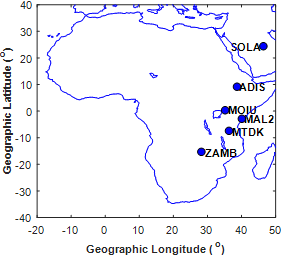GPS-TEC Variations over the African Low-latitude Ionosphereduring March 2013 and 2015 Geomagnetic Storms
Keywords:
Disturbance Electric Field, Equatorial ionosphere, Geomagnetic storms, GNSSAbstract
Intense geomagnetic storms offer opportunity to understand ionospheric response to space weather events. Using Total Electron Content (TEC) data from stations along the east African sector, the two most intense storms during the 24th solar cycle, with similarly occurrence season and time were studied. We observe that ionospheric effect during the main phase is not a function of the severity of the storm, whereas the more intense storm shows greater influence on the African ionosphere during the recovery phase. Plasma movement within the equatorial ionization anomaly (EIA) was evident particularly during the recovery phase, especially during the 2015 event. For both storms, the nighttime/early morning ionospheric effect is more pronounced than the daytime effects across all stations.

Published
How to Cite
Issue
Section
Copyright (c) 2020 Journal of the Nigerian Society of Physical Sciences

This work is licensed under a Creative Commons Attribution 4.0 International License.







